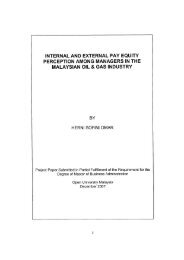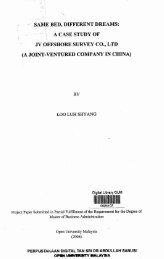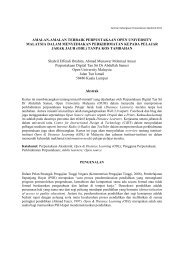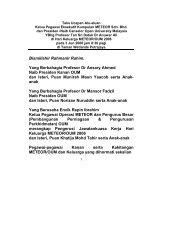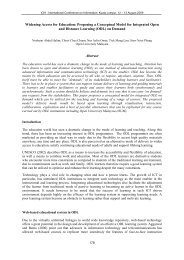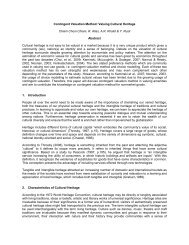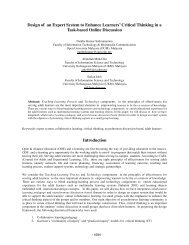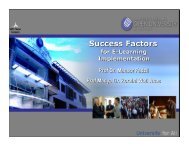The relationship between job satisfaction and job performance
The relationship between job satisfaction and job performance
The relationship between job satisfaction and job performance
Create successful ePaper yourself
Turn your PDF publications into a flip-book with our unique Google optimized e-Paper software.
HUBUNGAN DI ANTARA KEPUASAN KERJA DAN PRESTASI KERJA DIKALANGAN PEKERJA-PEKERJA DI KUMPULANSYARIKAT-SYARIKAT TRADEWINDSANUAR BIN HUSSINOktober 2011ABSTRAKKajian ini cuba menentukan tahap kepuasan kerja dan prestasi kerja serta mengenalpastihubungan di antara komponen-komponen kepuasan kerja iaitu (gaji, kenaikan pangkat,kerja itu sendiri, penyeliaan dan rakan sekerja) dan prestasi kerja di kalangan pekerjapekerjaKumpulan Syarikat-Syarikat Tradewinds. Kajian ini telah dijalankan ke atas 115responden di Kumpulan Syarikat-Syarikat Tradewinds di Lembah Klang. Di dalam kajianini, kaedah populasi keseluruhan telah digunakan. Hasil kajian ini juga mendapatibahawa terdapat hubungan positif di antara komponen kepuasan kerja iaitu (kenaikanpangkat, kerja itu sendiri, penyeliaan dan rakan sekerja) kecuali komponen gaji terhadapprestasi kerja. Terdapat juga perbezaan yang signifikan di antara kedudukan jawatanseseorang terhadap prestasi kerja. Hasil kajian ini juga telah membuktikan bahawadimensi kepuasan kerja iaitu (gaji, kenaikan pangkat, kerja itu sendiri, penyeliaan danrakan sekerja) boleh menyumbang sebanyak 17.8 peratus (%) bagi meningkatkan prestasikerja di dalam organisasi ini.Kata Kunci: kepuasan kerja, prestasi kerja, hubungan, komponeniv
Table of ContentsTitle PageDeclarationAbstractAbstrakAcknowledgementsTable of ContentsList of TablesList of FiguresiiiiiivvvixxiiCHAPTER 1INTRODUCTION1.1 Introduction 11.2 Background of the Study 21.3 Company Background 41.4 Problem Statement 41.5 Objectives of the Study 61.6 Research Questions 61.7 Research Hypothesis 71.8 Study Gap 81.8.1 Significance of the Study 91.9 Limitation of the Study 101.9.1 Definition of Terms 111.9.1.1 Employee Satisfaction 111.9.1.2 Pay 121.9.1.3 Promotion 121.9.1.4 Work itself 131.9.1.5 Supervision 131.9.1.6 Co-workers 131.9.1.7 Performance 14CHAPTER 2REVIEW OF LITERATURE2.1 Introduction 162.2 Job Satisfaction 162.2.1 Dimension of Job Satisfaction 212.3 Job Satisfaction Model 232.4 Porter-Lawler Expectancy <strong>The</strong>ory 252.5 Maslow’s Needs Hierarchy <strong>The</strong>ory 26vi
4.4 Pearson Correlation 654.4.1 <strong>The</strong> correlation <strong>between</strong> pay <strong>and</strong> employee<strong>job</strong> <strong>performance</strong> 674.4.2 <strong>The</strong> correlation <strong>between</strong> promotion <strong>and</strong>employee <strong>job</strong> <strong>performance</strong> 674.4.3 <strong>The</strong> correlation <strong>between</strong> work itself <strong>and</strong>employee <strong>job</strong> <strong>performance</strong> 684.4.4 <strong>The</strong> correlation <strong>between</strong> supervision <strong>and</strong>employee <strong>job</strong> <strong>performance</strong> 684.4.5 <strong>The</strong> correlation <strong>between</strong> co-workers <strong>and</strong>employee <strong>job</strong> <strong>performance</strong> 694.5 <strong>The</strong> influence of <strong>job</strong> <strong>satisfaction</strong> dimensions on <strong>job</strong><strong>performance</strong>. 704.6 <strong>The</strong> difference level <strong>between</strong> male & female <strong>and</strong> <strong>job</strong><strong>performance</strong>. 734.7 <strong>The</strong> difference level <strong>between</strong> position <strong>and</strong> <strong>job</strong><strong>performance</strong>. 74CHAPTER 5DISCUSSION AND CONCLUSIONS5.1 Introduction 765.2 Summary of Main Findings 765.3 Discussions <strong>and</strong> Findings 795.3.1 Relationship <strong>between</strong> pay <strong>and</strong><strong>job</strong> <strong>performance</strong> 815.3.2 Relationship <strong>between</strong> promotion <strong>and</strong><strong>job</strong> <strong>performance</strong> 825.3.3 Relationship <strong>between</strong> work itself <strong>and</strong><strong>job</strong> <strong>performance</strong> 835.3.4 Relationship <strong>between</strong> supervision <strong>and</strong><strong>job</strong> <strong>performance</strong> 845.3.5 Relationship <strong>between</strong> co-workers <strong>and</strong><strong>job</strong> <strong>performance</strong> 845.3.6 <strong>The</strong> difference level <strong>between</strong> male/female <strong>and</strong> <strong>job</strong> <strong>performance</strong> 855.3.7 <strong>The</strong> difference level <strong>between</strong> position <strong>and</strong><strong>job</strong> <strong>performance</strong> 86viii
5.4 Implications 885.5 Direction for Future Research 885.5.1 In-depth Research 885.5.2 Research on Different Industries 895.5.3 Research on the influence of <strong>job</strong><strong>performance</strong> on other areas. 895.6 Recommendation 905.6.1 Recommendation to the Organization 905.7 Conclusion 93REFERENCES 94APPENDICESviiii
ACKNOWLEDGEMENTAlhamdulillah to Allah the Almighty for putting forward me such a great strength, patience,courage <strong>and</strong> also ability to complete this project.My excessive gratefulness to my supportive <strong>and</strong> helpful supervisor, Associate Professor Dr.Hajah Sarminah Samad of UiTM for assessing <strong>and</strong> guiding me in completion of this research. Iam truly grateful to her continual support <strong>and</strong> cooperation, as being prepared to assist me allalong the completion of the project.My sincere thanks also go to my lovely mother Puan Hajah Hijar binti Haji Ibrahim, all myfamily members, friends <strong>and</strong> office colleagues for their support <strong>and</strong> underst<strong>and</strong>ing..v
LIST OF TABLESTable 3.1 Total Population 42Table 3.2 <strong>The</strong> Reliability of Variables of the Pilot Test 46Table 3.3 <strong>The</strong> Reliability of Variables of the Real Study 47Table 3.4 Interpretation of Strength Correlation 50Table 4.1 Summary of Respondents Demographic Analysis 52Table 4.2 Respondent: Gender 53Table 4.3 Respondent: Age 54Table 4.4 Respondent: Race 54Table 4.5 Respondent: Marital Status 55Table 4.6 Respondent: Length of Service 56Table 4.7 Respondent: Position 56Table 4.8 Respondent: Education Level 57Table 4.9 Descriptive Analysis on Pay 58Table 4.10 Descriptive Analysis on Promotion 59Table 4.11 Descriptive Analysis on the Work Itself 60Table 4.12 Descriptive Analysis on Supervisors 61Table 4.13 Descriptive Analysis on Co-Workers 62Table 4.14 Overall Level of Job Satisfaction <strong>and</strong> Job Performance 63Table 4.15 Descriptive Analysis on Job Performance 65Table 4.16 Correlations Analysis of the Variables 66x
Table 4.17 Summary of Multiple Regressions 71Table 4.18<strong>The</strong> Difference Level <strong>between</strong> Gender <strong>and</strong> JobPerformance 72Table 4.19<strong>The</strong> Difference Level of Job Performance according toPosition 74Table 5.1Descriptive Analysis on Job Satisfaction <strong>and</strong> JobPerformance 86xi
LIST OF FIGURESFigure 2.1 Job Dimension 22Figure 2.2 Hygiene <strong>and</strong> Motivation Factors 24Figure 2.3 Porter Lawler’s Model 25Figure 2.4 Maslow’s Hierarchy <strong>The</strong>ory 26Figure 2.5 Sources of Job Satisfaction <strong>and</strong> Job Dis<strong>satisfaction</strong> 29Figure 2.6 Possible Consequences of High <strong>and</strong> Low Job Satisfaction 31Figure 2.7 Research Framework 33Figure 2.8 Job Performance Dimension 38xii
REFERENCESAbdu Hakeem M. B Almarganhi (2008). <strong>The</strong> <strong>relationship</strong> <strong>between</strong> motivation <strong>and</strong>employee’s <strong>job</strong> <strong>performance</strong>. Master’s thesis. Universiti Utara Malaysia, Kedah.Abuduaini Wubuli (2009). A study on the factors affecting <strong>job</strong> <strong>satisfaction</strong> amongstemployees of fast food restaurants. Master’s thesis. Universiti Utara Malaysia,Kedah.Adam, J. S. (1963), Toward an underst<strong>and</strong>ing of inequity. Journal of Abnormal <strong>and</strong>Social Psychology, 422-436.Arnett, DB, Laverie, DA, & McLane, C (2002) Using <strong>job</strong> <strong>satisfaction</strong> <strong>and</strong> prideas internal marketing tools. Cornell Hotel <strong>and</strong> Restaurant AdministrationQuarterly, pp.87-96.Atkinson R., Smith E. (2000), Hilgard’s Introduction to Psychology 13 th Edition.Wadsworth Group, a Division of Thomson Learning Inc. (Harcourt, Inc 2000).Babin, B. J & Boles, J. S (1996). <strong>The</strong> effects of perceived co-worker involvement <strong>and</strong>supervisor support on service provider role stress, <strong>performance</strong> <strong>and</strong> <strong>job</strong><strong>satisfaction</strong>. Journal of Retailing, 72, 67-76.Bahar (2003), Dispositional affectivity <strong>and</strong> <strong>job</strong> <strong>performance</strong> mediating effects of <strong>job</strong><strong>satisfaction</strong>.Balasundram (2002), Job <strong>satisfaction</strong> & employee’s work <strong>performance</strong>: A case study ofpeople bank in Jaffna Peninsula, Sri Lanka.Bartol, K.M., Martin, D.C. (1998), Management, 3 rd edition, McGraw-Hill,New York. NY.94
Benggston, C., Vedin, J.A., Grimby, G. <strong>and</strong> Tibblin, G. 1978. Maximal WorkPerformance Test in Middle-aged Women: Results from a Population StudySc<strong>and</strong>inavian. Journal of Clinical <strong>and</strong> Laboratory Investigation, Volume 38,Issue 2, pp. 181-188.Bhuian, S. N., Menguc, B., & Borsboom R. (2005). Stressors <strong>and</strong> <strong>job</strong> outcomes in sales:A triphasic model versus a linear-quadratic-interactive model. Journal of BusinessResearch, 58, 141-150.Carmeli, A. (2003). <strong>The</strong> <strong>relationship</strong> <strong>between</strong> emotional intelligence <strong>and</strong> work attitudes,behavior <strong>and</strong> outcomes. An examination among senior managers. Journal ofManagerial Psychology, 18(8), 788-813.Campbell, J. P., McCloy, R. A., Oppler, S. H., & Sager, C. E. (1993) A theory of<strong>performance</strong>. In N. Schmitt & W. C. Borman (Eds.) Personnel selection inorganizations (pp. 35-70). San Francisco, CA: Jossey-Bass.Campbell, J. P., McHenry, J. J., & Wise, L. L. (1990). Modeling <strong>job</strong> <strong>performance</strong> in apopulation of <strong>job</strong>s. Personnel Psychology, 43, 313-333.Campion M. A, Cheraskin, L. & Stevens, M. J (2004). Career related antecedents &outcomes of <strong>job</strong> rotation. Academy of Management Journal. Vol. 37, pp. 1518-42Cetin, M. O. (2006). <strong>The</strong> <strong>relationship</strong> <strong>between</strong> <strong>job</strong> <strong>satisfaction</strong>, occupational <strong>and</strong>organizational commitment of academics. Journal of American AcademyBusiness, 8 (1): 78-88. Retrieved on 8 th October 2006 from ABI/INFORMGlobal.Churchill et. al., (1974), Job <strong>satisfaction</strong> <strong>and</strong> employee <strong>performance</strong> of Lebanese bankingstaff. Journal of Managerial Psychology, 18(4): 368-376. Retrieved on 15 August2006 from http: www.emarald-library.com.Crawford, J. C. <strong>and</strong> Nonis, S. 1996. <strong>The</strong> Relationship <strong>between</strong> Boundary Spanners’ JobSatisfaction <strong>and</strong> the Management Control System. Journal of Managerial Issues,Volume 8, Issue 1 125-134.95
Cranny, C. J., Smith, P.C., <strong>and</strong> Stone, E. F. (1992). Job Satisfaction: How People FeelAbout <strong>The</strong>ir Jobs <strong>and</strong> How It Affects <strong>The</strong>ir Performance. New York: LexingtonBooks.Deborah A. Cobb-Clark & Yvonne Dunlop (1999). 32. Monthly Labor Review.Ellickson, M.C., & Logsdon, K. (2002). Determinants of <strong>job</strong> <strong>satisfaction</strong> of municipalgovernment employees [Electronic version]. Public Personnel Management,31 (3), 343-358.Falkenburg, K. & Schyn, B. (2007). Work <strong>satisfaction</strong>, organizational commitment <strong>and</strong>withdrawal behaviors. Management Research News, 30 (10), 708-723.Fisher, C. D., Schoenfeldt, L.F., & Shaw, J. B. (1993). Human Resource Management(2 nd ed. ) Boston: Hounghton Miffin Company.Furnham, A. (1997). <strong>The</strong> psychology of behavior at work: <strong>The</strong> individual in theOrganization. Hove, East Sussex,UK: Psychology Press.Graen, G., Dansereau F., Minami T. (1972). Dsyfunctional Leadership Styles.Organizational Behavior & Human Performance.Gibbs, J. (2001). Pre-service education & qualification the impact on recruitment &retention in rural child protection. Rural Social Work, 6.pp.19-28Hunter, J. E., & Hunter, R. F. (1984). Validity <strong>and</strong> utility of alternative predictors of <strong>job</strong><strong>performance</strong>. Psychological Bulletin, 96, 72-98.Herzberg, F. Maunser, B., & Snyderman,B. (1959). <strong>The</strong> motivation to work. New York:John Wiley <strong>and</strong> Sons Inc.96
Ilham Dahir Sheikh Mohamoud (2009). <strong>The</strong> role of work motivation on employee<strong>performance</strong>. Master’s thesis. Universiti Utara Malaysia, Kedah.Iaffaldano, M. R., & Muchinsky, P. M. (1985). Job <strong>satisfaction</strong> <strong>and</strong> <strong>job</strong> <strong>performance</strong>: Ameta-analysis. Psychological Bulletin, 97, 251-273.Judge, T.A. Thoresen, C. J., Bono, J.E., & Patton, G.K. (2001). <strong>The</strong> <strong>job</strong> <strong>satisfaction</strong>-<strong>job</strong><strong>performance</strong> <strong>relationship</strong>: A qualitative <strong>and</strong> quantitative review. PsychologicalBulletin, 127, 376-407.Kakar, S.2002. Gender <strong>and</strong> Police Officers’ Perceptions of <strong>The</strong>ir Job Performance:An Analysis of the Relationship <strong>between</strong> Gender <strong>and</strong> Perceptions of JobPerformance. Journal of Criminal Justice Policy Review, Volume 13, Issue 3,pp. 238-256.Kerr, S. <strong>and</strong> Jemier J., (1978) Substitutes for leadership: <strong>The</strong>ir meaning <strong>and</strong>Measurement. Organisational Behaviour <strong>and</strong> Human Performance, 22, 375-403.Lawler, E <strong>and</strong> Porter, L. (1967). <strong>The</strong> effect of <strong>performance</strong> on <strong>job</strong> <strong>satisfaction</strong>.Industrial Relations, 7, 20-28.L<strong>and</strong>y, F. J, (1989), Psychology of Work Behavior. Pacific Grove. CA;Brooks/Cole.Lee, T. W., & Mowday R. T. (1987), Voluntarily leaving an organization. An empiricalinvestigation of steers <strong>and</strong> Mowday’s model of turnover. Academy ofManagement Journal, 31 (5), 721-743.Lee, Geon. And Benedict, J. 2009. “Does Organizational Performance Make aDifference to Public Employees Job Turnover in the Federal Government? Paperpresented at the annual meeting of the Midwest Political Science Association 67 thAnnual National Conference, the Palmer House Hilton, Chicago, IL, April 02,2009.Locke, E. A (1970), Job <strong>satisfaction</strong> <strong>and</strong> <strong>job</strong> <strong>performance</strong>: A theoretical analysis.Organizational Behavior & Human Performance, 5, 484-500.97
Locke, E. A (1976) <strong>The</strong> nature <strong>and</strong> causes of <strong>job</strong> <strong>satisfaction</strong>. In M. D. Dunnette (Ed.)H<strong>and</strong>book of industrial <strong>and</strong> organizational psychology (pp.1297-1349). Chicago: R<strong>and</strong> McNally.Locke, E. A. (2001). Organizational behavior: affect in the workplace. Annual Reviewof Psychology, 53, 279-307,282.Longman Dictionary of Contemporary (3 rd ed.): English New Edition. 2000.Mardiana Azila Mohd, Norsyalina Nordin & Siti Noraziana Aris (2010). <strong>The</strong> <strong>relationship</strong><strong>between</strong> manager’s leadership style & employee <strong>job</strong> <strong>satisfaction</strong>. A case study ofCourts Mammoth Sdn Bhd. Master’s thesis. Universiti Teknologi Mara, ShahAlam.Masdia Masri (2009). Job <strong>satisfaction</strong> <strong>and</strong> turnover intention among skilled personnel inTRIplc Bhd. Master’s thesis. Universiti Utara Malaysia, Kedah.Maslow, A. (1943). A <strong>The</strong>ory of Human Motivation. Psychological Review, 50, 370-396.McCormick, G. J. & Ligen, W. R. (1985). Perceived overqualification <strong>and</strong> dimensions of<strong>job</strong> <strong>satisfaction</strong>: A longitudinal analysis. <strong>The</strong> journal of psychology, 134 (5): 537-555. Retrieved on September 2006 from EBSCO host Full Display.McCormick, E. J & IIgen, D. (1985). Industrial <strong>and</strong> Organizational Psychology (8 th ed).New Jersey: Prentice Hall.Mitchell, T. R. (1982). “Motivation: new direction for theory, research <strong>and</strong> practices”,Academy of Management Review, Vol. 7 pp 80-8.Murphy, K. R. (1989). Dimensions of <strong>job</strong> <strong>performance</strong>. In R. F. Dillon <strong>and</strong> J. W.Pellegrino (Eds.) Testing: <strong>The</strong>oretical <strong>and</strong> Applied Perspectives (pp. 218-247).New York: Praeger.98
Mueller, C. W. & Price, J. L. (1990). Economic psychological <strong>and</strong> sociologicaldeterminants of voluntary turnover. <strong>The</strong> Journal of Behavioral Economics, 19 (3),321-335.Mobley, W, Griffeth, R, H<strong>and</strong>, H & Megliano, B (1979), Review <strong>and</strong> conceptual analysisof the employee turnover process. Psychological Bulletin, Vol.86, pp 493-552.Monday, R. W. & Noe, R. M. (1990). Human Resource Management. (4 th ed.). UnitedState of America: Allyn <strong>and</strong> Bacon.Milliman, J. F, Fergusan, J.M Czaplewski, A. J (2008), Breaking the Cycle; MarketingManagement, Mar/Apr 2008, Vol. 17, Issue 2, P14-17.Neely, A., Gregory, M. & Platts, K (1995). Performance Measurement System Design.International Journal of Operational <strong>and</strong> Production Management, 15(4),80-116.Nezaam Luddy (2005), Job <strong>satisfaction</strong> amongst employees at a public health institutionin the Western cape.Organ, D. W. (1998). A restatement of the <strong>satisfaction</strong>-<strong>performance</strong> hypothesis. Journalof Management, 14, 547-557.Organ, D.W., & Ryan, K. (1995). A meta-analysis review of attitudinal <strong>and</strong> dispositionalPredictors of organizational citizenship behavior. Personnel Psychology, 48, 775-802.Pearson , R. (1991). <strong>The</strong> Human Resource: Managing people <strong>and</strong> Work in the 1990s.London: McGraw-Hill Book Company.Rajendran Vignaswaran (2005). <strong>The</strong> <strong>relationship</strong> <strong>between</strong> <strong>performance</strong> appraisal<strong>satisfaction</strong> <strong>and</strong> employee outcomes: A study conducted in Peninsular Malaysia.Master’s thesis. Universiti Malaya, Kuala Lumpur.99
Rain, JS, Lane, IM & Steiner, D.D 1991, A current look at the <strong>job</strong> <strong>satisfaction</strong>/life<strong>satisfaction</strong> <strong>relationship</strong>: Review <strong>and</strong> future considerations. Human Relations,p. 44 pp. 287-307.Reicheld, FF (1996), <strong>The</strong> loyalty effect: <strong>The</strong> hidden force behind growth, profits <strong>and</strong>lasting value. Bain & Company, Inc, Boston.Robbins, S. P (2005). Organizational behavior (11 th ed.) New Jersey: Prentice hall.Roebuck, D. B., Sightler, K.W <strong>and</strong> Brush C.C. 1995. Organizational Size, CompanyType <strong>and</strong> Position effects on the Perceived Importance of Oral <strong>and</strong> WrittenCommunication Skills. Journal of Managerial Issues, Volume 7, Issue 3,pp. 77-85.Saker, AH, Crossman, A <strong>and</strong> Chinmeteepituck, P. 2003. <strong>The</strong> <strong>relationship</strong>s of age <strong>and</strong><strong>and</strong> length of service with <strong>job</strong> <strong>satisfaction</strong>: An examination of hotel employeesin Thail<strong>and</strong>. Journal Managerial Psychology, p. 18, pp. 745-58.Schermerhorn, J. R., Jr. (1986) Management for productivity (2 nd ed). NY: John Wiley& Sons.Schwab, D. P. & Cummings, L. L. (1970). <strong>The</strong>ories of <strong>performance</strong> <strong>and</strong> <strong>satisfaction</strong>: Areview. Industrial Relations, 9, 408-430.Shaiful Anuar, K., Kamaruzaman, J., Hassan A., Mohamad, I., Kamsol, M. K. <strong>and</strong>Norhashimah, A. R. 2009. Gender as Moderator of the Relationship <strong>between</strong>OCB <strong>and</strong> Turnover Intention. Journal of Asian Social Science, Volume 5, Issue,pp. 6 108-117.Sherman A., G. Bohl<strong>and</strong>er & S. Snell (1998), Managing Human Resources, Cincinnati,Ohio: South-Western College Publishing.Siti Aishah Panatik (2010), Impact of Work Design on Psychological Work Reactions<strong>and</strong> Job Performance among Technical Workers: A Longitudinal Study inMalaysia. PhD’ thesis. University of Waikato New Zeal<strong>and</strong>.100
Sohi, R. S (1996). <strong>The</strong> effects of environmental dynamism <strong>and</strong> heterogeneity onsales people’s role perceptions, <strong>performance</strong> <strong>and</strong> <strong>job</strong> <strong>satisfaction</strong>. EuropeanJournal of Marketing, 30 (7), 49-67.Smith, Kendall & Hulin (1969)- Smith, P. C., Kendall, L. M & Hulin, C. L (1969). <strong>The</strong>measurement of <strong>satisfaction</strong> in work <strong>and</strong> retirement. Chicago: R<strong>and</strong> McNally.Spector, P. E. (2000). Industrial & organizational psychology (2 nd ed.). New York:John Wiley & Sons.Stodgill, R (1974), H<strong>and</strong>book of Leadership. New York. Free Press.Tan Teck Hong & Amna Waheed. Asian Academy of Management Journal. Vol. 16,No.1, 73-94, Jan. 2011.Tuten, T. L & Neidermeyer P. E (2004). Performance, Satisfaction <strong>and</strong> Turnover in CallCenters. <strong>The</strong> Effects of Stress <strong>and</strong> Optimism. Journal of Business Research,57 (1), 26-34.Vroom, V. H. (1964). Work <strong>and</strong> Motivation. New York: Wiley.Viswesvaran, C. (1993). Modeling <strong>job</strong> <strong>performance</strong>. Is there a general factor?Unpublished doctoral dissertation, University of Iowa, Iowa City.Wright, T. A., <strong>and</strong> Cropanzano, R., (1997). Well being <strong>satisfaction</strong> <strong>and</strong> <strong>performance</strong>;another look at happy / productive worker thesis. Paper presented at the AnnualMeeting of the Academy of Management, Boston, USA.www. incentivequotes.com/employee-motivation.html. Employee motivation in theworkplace (2010). Coleman Research Group.101



